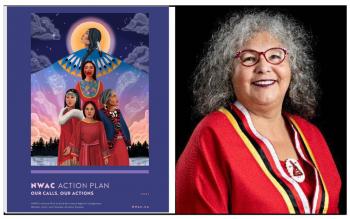Image Caption
Summary
Local Journalism Initiative Reporter
Windspeaker.com
Working with the federal government on a national plan to take action on violence perpetrated against Indigenous women and girls resulted in the members of the Native Women’s Association of Canada experiencing the very thing the organization has worked almost 50 years to protect other Indigenous women from—lateral violence.
So they did what they hope they can give other women the strength to do, said NWAC President Lorraine Whitman. They walked away.
And NWAC launched its own action plan on Tuesday. During a press conference to announce the NWAC plan, Whitman spent considerable time explaining why her organization “with great regret” bolted from the larger group. It was assembled by Crown-Indigenous Relations Minister Carolyn Bennett in response to the national inquiry’s final report into missing and murdered Indigenous women and girls (MMIWG) and gender-diverse people.
“We had huge hopes that when the final report was released real action would be taken,” said Whitman. “We believe that the approach (the government is) taking is fundamentally flawed and inconsistent with the 231 Calls for Justice.”
The two-volume final report from the national inquiry was delivered June 3, 2019, and put forward 231 Calls for Justice directed at governments, institutions, social service providers, industries and all Canadians with the goal of bringing about legal and social change.
Whitman said NWAC was denied a seat on key working committees where the main ideas for a national action plan were formulated and because of that they were shut out of the major decision-making processes for creating the action plan, including concrete actions and implementation of those actions.
While other organizations received government funding to participate in the process, NWAC did not, she said.
It was a major blow for NWAC, who “first sounded the alarm” about violence against Indigenous women and who were “at the forefront” for a national inquiry on MMIWG, said Whitman.
“We were clearly an afterthought and perhaps even unwelcomed intruder in the government’s process,” she said.
When NWAC was permitted on committees, Whitman claimed representatives were subjected to lateral violence and hostility.
“It eventually reached levels that forced us to walk away,” she said.
A letter was sent to Bennett last week saying NWAC had withdrawn from the process and would not be standing with the federal government on June 3 when the government announces its plan.
At a news conference this morning, Bennett said she was “grateful” for all the work NWAC had done in the past in leading the charge in bringing awareness about violence against Indigenous women.
“I think that as we designed the process it had to include provinces and territories, the distinctions-based representative organizations, as well as focus on two-spirt data (and) urban that we ended up with a core working group that has done extraordinary work,” said Bennett.
She said she was confident the government’s action plan would be the “blueprint forward to move into the implementation phase.”
“We will continue to do that work in partnership with all of those who are doing the work on the ground of keeping women and girls and two-spirited LGBTTTQQIAA-plus people safe in their home communities, as well as in urban centres and wherever they live and we are committed to do that work going forward,” said Bennett.
She said Budget 2021 had allocated $2.2 million to support the work of the response to the national inquiry.
“We genuinely want to work with the government,” said Whitman, who added she was looking forward to seeing the government’s “list of costed actions that will be taken starting immediately to address the ongoing violence.”
“(NWAC’s plan) is not meant to supplant what the federal government or other parties intend to do. It is meant to complement their work and to be complemented by their work,” said Whitman.
NWAC will be asking for federal funding for its own $29 million per year action plan, which outlines 65 actions to be taken which align with the 231 Calls for Justice. Only $1 million is currently being funded. Along with asking for federal dollars, Whitman said they will try to tap into all levels of government, non-governmental organizations, private donors and organizations.
“This is a plan developed by Indigenous women for Indigenous women and will be actioned by Indigenous women,” said Whitman.
Entitled “Our Calls, Our Actions,” the core of the plan is the creation of resiliency lodges throughout the country. Resiliency lodges will be places for healing; prevention and intervention; counselling and support services; and delivery of health, wellness, spiritual, cultural and language programs. One resiliency lodge has been built in Chelsea, Que.
Other initiatives pertain to physical, mental, protective, social and human security; to ensuring awareness and accountability in the international arena; justice through working with the police, the court system and the correctional system; and public awareness to generate broader public understanding of the issues.
“We need everyone, every level of government, every Canadian working with us and the Indigenous women of this country to end this violence. And that work begins today because the cost of doing nothing for even another day is just too great. We must protect the lives of Indigenous women, girls and gender-diverse people. That is our legal and moral responsibility as Canadians. We must end the genocide,” said Whitman.
Local Journalism Initiative Reporters are supported by a financial contribution made by the Government of Canada.

